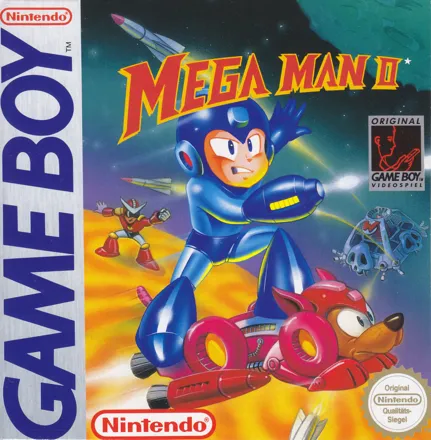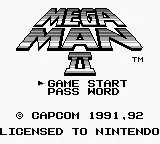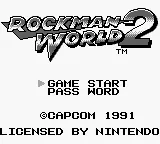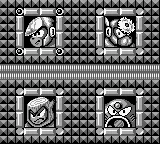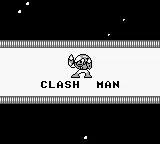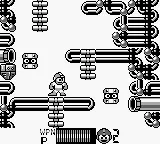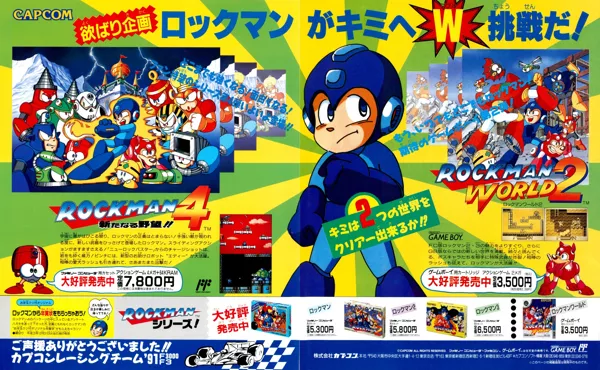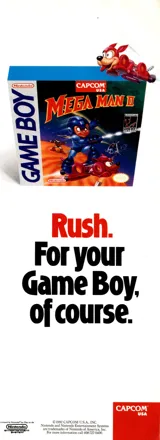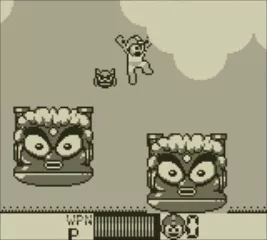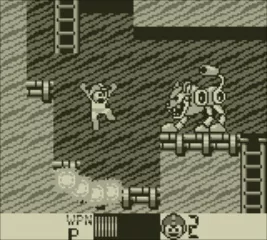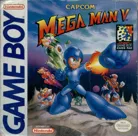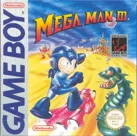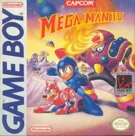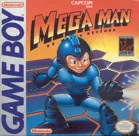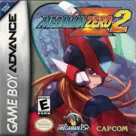Mega Man II
Description official description
Dr. Wily has broken into the Chronos Institute and stolen a machine called Time Skimmer. According to Dr. Light's calculations, he has used the machine to travel roughly 37,426 years into the future. This can mean nothing good and so Mega Man, along with his dog Rush, sets out to find out more about Dr. Wily's plans.
Mega Man II follows the same formula as its predecessors, meaning the player has to complete a number of side-scrolling, platforming levels that are guarded by different bosses. Mega Man can only shoot left or right, but defeating a boss rewards him with a new weapon. Sometimes he will also find upgrades for Rush, which enable him to use Rush as a trampoline, a submarine or a jet.
While Mega Man II is not a conversion, the first four stages look and play very similar to some levels of Mega Man 2 for the NES. Likewise, levels five to eight resemble some levels of Mega Man 3. The bosses of the first eight stages are also old familiars from Mega Man 2 and 3.
Spellings
- ロックマンワールド2 - Japanese spelling
Groups +
Screenshots
Promos
Credits (Game Boy version)
| Music Composer (uncredited) |
Reviews
Critics
Average score: 66% (based on 13 ratings)
Players
Average score: 3.4 out of 5 (based on 16 ratings with 2 reviews)
Not bad, but can't stand up to his its brothers
The Good
In comparison to Mega Man: Wiley's Revenge, this game has slightly longer stages and stages for all eight Robot Masters, not just for the first four. The graphics are sharp and clear, the controls smooth, hit detection fits and the overall graphical design is nice. More elements from the NES series have been introduced here too: Mega Man can slide, use Energy Tanks and has Rush (as Coil, Jet and Marine) at his disposal. The Robot Masters themselves are from two different NES games and there's an additional Mega Man Killer, so there's some variety for the ones who played the NES version too.
The Bad
The music is terrible! The themes are the ones from the NES games, but poorly remixed. And some weapons are useful throughout the whole games, others are only good for fighting the Robot Master who's weak against them. The Weapons of Needle Man, Hard Man and Clash Man (yes, he has been renamed from Crash Man to Clash Man, but I don't care) are almost identical to the Proto Cannon. You basically can't use Top Spin without getting hurt, so that one is useless as well.
To the difficulty: The game is waaay to easy. Enemies don't do much damage, there are Weapon Energy, Health and Energy Tanks everywhere, the bosses are easy to defeat with just the Proto Cannon. With the right weapon, they go down like nothing. And Quint, the Mega Man Killer, is the most pathetic Robot Master of the whole series! Rush lowers the difficulty even more: With Rush Jet, you can skip most jumping sections.
The Bottom Line
Mega Man II is enjoyable, but won't last long. You may want to skip to Mega Man III, IV or V, which did a better job.
Game Boy · by Katharian Berg (17) · 2010
The Good
The Mega Man series is one of my favourite corners of the NES library. While the gameplay is pretty much the exact same from entry to entry, the tight controls and excellent design is almost peerless on the console, which more than makes up for their lack of inventiveness. Yet, my introduction to the series wasn’t even on the NES; it was on the Gameboy. While I drooled over images of Mega Man 2 and 3 in a password book I had as a small child, it wasn’t until years later that I got my first taste in Dr. Wily’s Revenge on the old dot-matrix handheld. It has been a while since I last replayed it, but if I recall correctly, it’s a decent transition from the original formula. Despite this, I never really moved on to the other entries in the Gameboy series. I’ve now had the chance to play through the confusingly named Mega Man II (not to be confused with the NES’s Mega Man 2), and I’m left wondering what the heck happened.
The game starts without introduction, throwing you into the classic stage select screen of 4 robot masters, which, from the outset, is a smaller number than even the original NES Mega Man’s six, but rest assured that four more show up after the first set are thwarted. It’s a mix of bosses from Mega Man 2 and 3 on the NES, which is an interesting way of shaking things up without any actual effort, but it is unfortunate that there isn’t a completely new set.
Bosses aren’t the only reused mechanics from the NES titles. Both Mega Man’s dog, Rush, and the slide from Mega Man 3 appear, though the charge shot from the fourth game is still absent. With the return of Metal Man, the Metal Blade power-up is here and it’s just as overwhelmingly useful as it was in Mega Man 2 (NES). However, the game’s difficulty is significantly lower than any of the NES titles, so the metal blade’s eight-directional attack is rarely necessary. I’m also not sure why someone thought Top Man was worth carrying over to the portable format, but there you have it.
The Bad
While taking what are arguably the two best games in the Mega Man series and mashing them together should result in an excellent portable experience, the feeling that pervades all of Mega Man II’s runtime is one of thoughtlessness. The gameplay itself is untouched from the previous games, yet the overall design has taken a turn for the worse. Item distribution is slapdash, allowing for imbalances, such as the pickup of multiple e-tanks in extremely accessible areas in the same stage.
The graphics have been understandably downgraded from the console versions, but the sprite work, when it isn’t ripped directly from the NES games, is absolute crap. There’s one entirely new character in the entire game and he looks like Proto Man’s dorky brother on a pogo stick and fights like one would expect from such an amalgamation. Even a few of the enemies that have just been downsized to fit the tighter rooms have had their proportions thrown completely out of whack. In every visual aspect, the game is a wreck.
Speaking of the game’s visual issues, the obstacles in each of the stages aren’t diverse enough to make one level feel distinct from the others. Even compared to the NES series’ stages, they’re incredibly vanilla. They show no creative obstacles like the force beams in Mega Man 2’s Quick Man stage or the vast underwater sections of Bubble Man’s; it’s all so unambitious. At least Air Man’s big floating heads are still present in his stage, despite the fact that they’re arguably the worst designed obstacle in Mega Man 2.
Even worse is that a lot of the visual flair has been sucked out in the transition to monochrome. The floors and walls all mimic the related NES stages, and there are some attempts of replicating some of the backgrounds, but for the most part, the visual changes between stages are incredibly subtle. This is perhaps expected due to the conversion to compensate for the four shade palette, but I wish there was some ambition in making the stages appear distinct.
It’s also a considerably shorter experience than any of the NES titles, almost shockingly so. While this is normally forgivable given that it exists on a platform that runs on batteries, there’s no excuse for the startling lack of content. While the series’ standard eight robot masters are present, only four are selectable from the offset, with the other four available once reaching Wily’s Castle. Wily’s Castle itself only consists of one short and quite simple stage with no sub-bosses. The bosses that do show up are generally unimpressive, and rarely did I ever find it necessary to switch away from Mega Man’s standard buster.
Then there’s the music, which at times shows vague indications that it takes inspiration from the classic tunes featured in the NES titles, but more often descends into a cacophony of high-pitched squeals and dull ticks and thuds. Some of the tracks are so uncomfortable to listen to that I had to turn the volume down to tolerate them. I honestly am uncertain if the included songs are remakes of ones found in the NES versions, but if they are, then they are poor facsimiles to the point of being unrecognizable.
The Bottom Line
While it’s not far and away the worst Gameboy game I’ve encountered, it is easily the worst Mega Man game I’ve played to date. To be fair, I didn’t suffer too much while I trekked through its poorly laid out stages, but I owe that largely to its brevity and toothless challenge. It feels like the team who created it knew nothing of what makes a Mega Man game actually good. The controls feel all right, sure, but there’s no flow to anything. It all feels so slapped together and haphazard. And while nothing about it descends into the territory of offensively horrid, it demonstrates that not a lot of thought was really put into it. It’s BAD in a way I never thought a Mega Man game could be. The fact that it’s put together from parts torn out of the second and third entries in the NES series makes the whole thing feel like a bodysnatcher is wearing the skin of an old friend. My entire perspective on the series has been changed with this brand new low.
Game Boy · by Adzuken (836) · 2015
Analytics
Identifiers +
Contribute
Are you familiar with this game? Help document and preserve this entry in video game history! If your contribution is approved, you will earn points and be credited as a contributor.
Contributors to this Entry
Game added by Mobygamesisreanimated.
Nintendo 3DS added by GTramp. Nintendo Switch added by Kam1Kaz3NL77.
Additional contributors: chirinea, Freeman.
Game added May 26, 2006. Last modified April 12, 2025.


